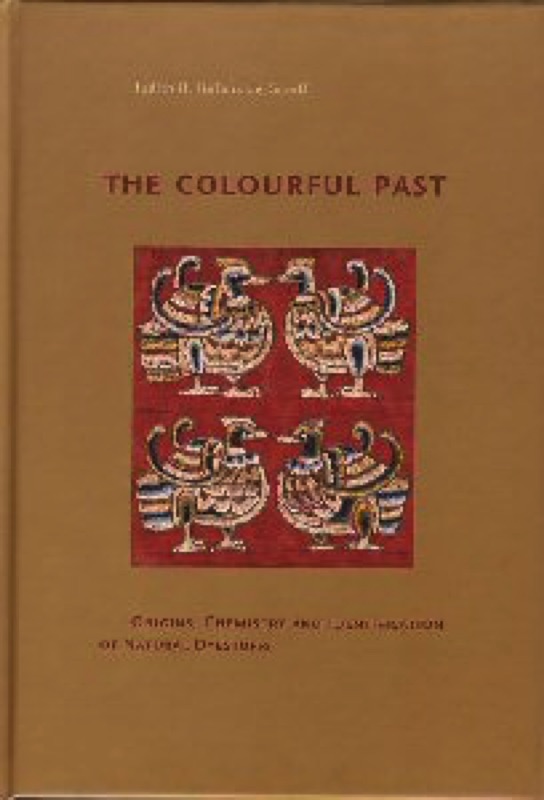This publication is intended to provide a quick overview of well-known dyestuffs that can be found in objects of cultural value in order to contribute to the knowledge of historic textiles and their preservation. Aimed mainly at conservators, conservation students, curators and textile historians, the book presents information on the most relevant dyestuffs used for dyeing textiles, the relation between dyestuffs and organic pigments in paintings and their historical relevance. Emphasis is placed on the combination of historical, technical and scientific knowledge and the way it can be used for the benefit of the conservation of historic textiles.
Until the early 1980s the identification of natural dyestuffs was developed and carried out using thin-layer chromatography (TLC) but the development of high performance liquid chromatography (HPLC) opened up greater possibilities and over the past 30 years hundreds of historic textiles have been investigated using this technique. From many investigations carried out for individual museums and institutions, the author has chosen a number of case studies to illustrate both the possibilities and limitations of dyestuff analysis.
This title, is published by Archetype Publications Ltd and Abegg Stiftung, Riggisberg, Switzerland (www.abegg-stiftung.ch).
Preface
Acknowledgements
Dyeing with natural dyes
History of textile dyeing
Principles of textile dyeing
Identification of natural dyestuffs
Introduction
Microchemical analysis
Thin-layer chromatography
High performance liquid chromatography
Red dyestuffs
Alkanna
Henna
Coccid dyestuffs
Introduction
Kermes
Polish cochineal
Armenian cochineal
Cochineal
Lac-dye
Madder type dyestuffs
Introduction
Madder
Wild madder
Munjeet
Chay root
Galium species
Relbunium species
Indian mulberry
Redwoods
Introduction
Brazilwood
Red sandalwood
Safflower
Yellow dyestuffs
Annatt
Barberry root
Yellowwoods
Introduction
Young fustic
Fustic
Quercitron
Persian berries
Saffron
Turmeric
Weld, dyer's broom and sawwort
Introduction
Weld
Dyer's broom
Sawwort
Blue dyestuffs
Logwood
Indigoid dyestuffs
Introduction
Woad
Indigo
Indigo carmine
Purple dyestuffs
Tyrian purple
Orchil
Black dyestuffs
Gallotannin dyestuffs
Introduction
Galls
Alder bark
Sumac
Catechu
Black walnut
Appendix: Essays
Dyeing black in 17th-century Holland
Textile dyeing in Leiden: changes in the use of dyestuffs from the 16th to the 17th century
Historical sources from a scientific point of view
Recycling in the 17th-century textile industry
Indian chintz and its European imitations: unravelling the technology
Bibliography
Index
Index of Latin names
Reviews
Das Buch fällt durch sein schönes, übersichtliches Layout und seinen systematischen Aufbau auf. Die umfangreiche Bibliographie am Ende des Buches umfasst an die 350 Zitate. Zusätzlich findet man bei jedem Kapitel Literaturangaben...Dieses Standardwerk auf dem Gebiet der Naturfarbstoffe ist durch seine spezielle Gestaltung einem großen Personenkreis zu empfehlen. Für Textilsammlungen verantwortliche Kustoden/innen und Textilrestauratoren/innen zählen ebenso dazu wie im Bereich Textilien arbeitende Kunsthistoriker/innen, Ethnologen/innen und Archäologen/innen, auf Naturfarbstoffe spezialisierte Naturwissenschaftler/innen und alle an historischen Textilien und Textilfärbetechniken Interessierte.
RESTAURO (November 2005)
...beautifully presented book...packed with historical, technical and scientific information, gathered from many years of research...Although this book is aimed mainly at conservators, conservation students, museum keepers and textile historians, it contains a wealth of information to interest…natural dyers.
Journal for Weavers, Spinners and Dyers 213 (March 2005) 39
Clearly useful as a dye reference...This is a lovely book, and one to which other researchers can look to for inspiration.
Journal of the Canadian Association for Conservation 29 (2004) 38-39
